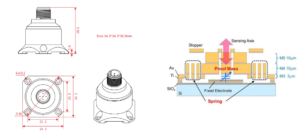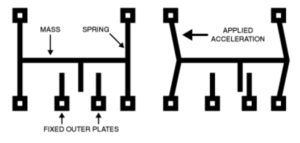Shrinking Electronics, Growing Possibilities: The Evolution of MEMS Technology
Written by: Samantha Narchetty
In the 1959 lecture, “There’s Plenty of Room at the Bottom,” Richard Feynman describes a new type of electronic component: electric motors with the size of the tip of your finger, the ability to write all volumes of the Encyclopedia Britannica on the head of a pin, and the general possibility to convey immense amounts of information on an immensely small scale. These technologies mark the advent of MEMS technologies and the beginning of an electronic revolution. Now, they serve as the basis for the electronics in the smartphones we carry around in our pockets, the appliances we use daily, and even new technologies such as drones.
What is MEMS technology?
The acronym MEMS stands for microelectromechanical systems, named after their ability to miniaturize conventional machinery. These micro-machines often employ miniaturized channels, membranes, and springs to create smaller electronic components by taking advantage of smaller-scale physics.
This technology allows MEMS electronics, specifically MEMS sensors, to offer the same functionality as their larger counterparts while maintaining a smaller form factor (1 mm to a micron), something that is mainly attributed to cheap, scalable, and efficient manufacturing processes. MEMS sensors use fabrication techniques similar to those of integrated circuits (ICs). where a silicon wafer, or other material, is chemically etched to make micro-features on the surface of the chip. This fabrication process makes larger quantities of MEMS sensors at cheaper prices and utilizes fewer materials further reducing costs, and MEMS’s manufacturing method also ensures better integration through MEMS sensors’ similarity with ICs allowing for one or more of these sensors to easily be attached to already existing microelectronics.
Additionally, MEMS sensors are much more practical than the larger metal ball and spring accelerometers, and they allow for smaller devices like smartphones. As shown below in Figure 1, where traditional electronic sensors are measured in millimeters, MEMS sensors are measured on the magnitudes of microns, allowing for precise measurements in small spaces.
Figure 1

Side-by-side comparison of a metal ball accelerometer (left) and a MEMS accelerometer (right) diagrams with dimensions
Credits to ATO and EurekAlert!
The Miniaturization Problem
While MEMS sensors are smaller versions of existing sensors, simply scaling bigger versions of electronic sensors fails because of scaling laws. Take a cube and scale it by a scaling factor, s. The surface area of each of the sides of the cube scale is s2 and the volume of the cube scales at a factor of s3. At smaller scales, surface area forces have a larger impact than volume, meaning that sensors, such as the metal ball accelerometer shown above, will behave differently on the scale of microns.
Therefore, engineers must come up with novel ways to deliver the same functionality by utilizing physics at smaller scales. One example of such ingenious engineering is the MEMS accelerometer, used in everything from the airbag deployers in cars to the navigation in drones and more. Figure 2 demonstrates a simplified crash MEMS accelerator where a mass is attached to beams that act as springs. Upon impact with a fixture or another vehicle, the mass moves forward, resulting in a measurable change in capacitance—a ratio between the change in electric charge in a system and a corresponding change in electric potential—between the fixed inner “teeth” and the outer fixture. This enables the MEMS sensor to detect the crash and deploy airbags accordingly.
Figure 2

A simplified image of a crash MEMS sensor
Source: Mouser Electronics
Current MEMS Sensor Development
Currently, MEMS sensors are continuing to enable new technologies. Autonomous vehicles, for example, utilize these MEMS sensors as a part of anti-locking braking systems, automatic suspension adjustments, and tire pressure monitoring, allowing for safer vehicles and fewer accidents. This need for MEMS sensors, particularly in the automotive industry, is expected to drive rapid MEMS sensor development.
Additionally, the small form factor of these sensors allows for sensor fusion, where multiple sensor functionalities can be combined into one device. This current area of development promises to improve mobile devices by including multiple functionalities, where accelerometers, gyroscopes, and pressure sensors can be combined into one singular chip, leaving more space for more components leading to more functionality.
Current research into MEMS components hopes to introduce new materials, more efficient designs, and cheaper fabrication methods that allow MEMS technology to reach new applications (biomedical, environmental, etc.).
Conclusion
At the beginning of the development of MEMS technologies, Richard Feynman famously predicted the ability to write an entire library’s worth of knowledge on a single chip, yet we now see the development of MEMS technology has allowed us to have modern MEMS-based chips that can store thousands of libraries. The evolution of this technology has seen remarkable progress in MEMS advancements, including the creation of the first silicon pressure sensor, advancements in silicon etching processes, the development of MEMS printer nozzles, bulk micromachining techniques, and the proliferation of optical MEMS sensors. The future of MEMS technology promises even more innovation poised to revolutionize existing technologies and future technologies a second time. While MEMS technology has shrunk in terms of scale, it has expanded the horizons of what is possible regarding electronic components’ functionality, fabrication, and integration.
The development of these microelectronic components will continue, driven by the need for smaller implantable devices, safer vehicles, smarter phones, and better robot locomotion, promising a bright future for MEMS technology. With each new development, MEMS technology achieves Richard Feynman’s vision of converting immense information and small scales at new scales.
References and Sources
Askew, D. (2024). MEMS: A Brief Overview. Mouser Electronics. Retrieved April 9, 2024, from https://www.mouser.com/applications/mems-overview/
Feynman, R. P. (1959, December 29). There’s Plenty of Room at the Bottom [an invitation to enter a new field of physics]. https://calteches.library.caltech.edu/47/2/1960Bottom.pdf
Florida International University. (2012). MEMS for Biomedical Applications. https://pdf.sciencedirectassets.com/308168/3-s2.0-C20130161661/3-s2.0-B9780857091291500213/main.pdf?X-Amz-Security-Token=IQoJb3JpZ2luX2VjEMP%2F%2F%2F%2F%2F%2F%2F%2F%2F%2FwEaCXVzLWVhc3QtMSJHMEUCICdz7YP1%2BpumBjzc5Wl5RrK5CFfgApmfPyVEN%2F5B8SBUAiEAw9zrxivODWZ
How are MEMS (micro-electro-mechanical systems) made? (n.d.). TWI Global. Retrieved April 9, 2024, from https://www.twi-global.com/technical-knowledge/faqs/faq-how-are-mems-micro-electro-mechanical-systems-made
How Does a MEMS Sensor Work? (2024). Jewell Instruments. Retrieved April 9, 2024, from https://jewellinstruments.com/support/how-does-a-mems-sensor-work/
MEMS Sensor Market – Micro-Electro-Mechanical Systems – Size & Share. (n.d.). Mordor Intelligence. Retrieved April 9, 2024, from https://www.mordorintelligence.com/industry-reports/mems-sensor-market
Nagle, D. (n.d.). Parallel Data Laboratory. Parallel Data Laboratory. Retrieved April 9, 2024, from https://www.pdl.cmu.edu/MEMS/overview.shtml
What is MEMS Technology? (2023). SBG Systems. Retrieved April 9, 2024, from https://www.sbg-systems.com/support/technology/mems-technology-imu-ahrs-ins/
1 thoughts on “Shrinking Electronics, Growing Possibilities: The Evolution of MEMS Technology”